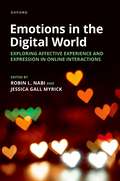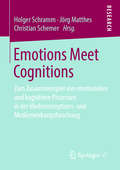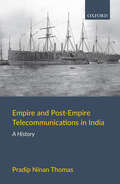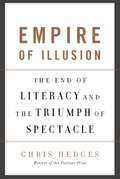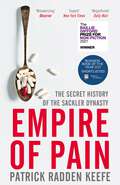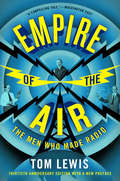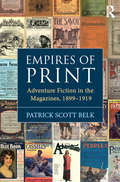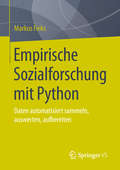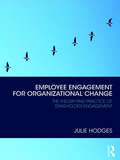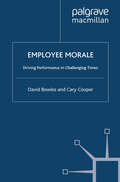- Table View
- List View
Emotions in the Digital World: Exploring Affective Experience and Expression in Online Interactions
by Robin L. Nabi and Jessica Gall MyrickThis edited volume examines the ways in which rapidly changing technologies and patterns of media use influence, and are influenced by, our emotional experiences. Following introductory chapters outlining common conceptual frameworks used in the study of emotion and digital media effects, this book is then organized around four general areas highlighting the intersection of technology use and emotional experience: how people experience, and researchers measure, emotions in response to digital media use; potential emotional harms and enrichments resulting from online behaviors; the socio-emotional dynamics of online interaction; and emotion's role in engagement with online information. Chapters span a wide range of topics, including physiological and neuroscientific responses to new media, virtual reality, social media and well-being, technology addiction, cyberbullying, online hate and empathy, online romantic relationships, self-presentation online, information seeking, message sharing, social support, polarization, misinformation, and more. Through a social scientific lens, contributing authors provide nuanced, interdisciplinary perspectives on these salient social phenomena, offering cogent reviews and critiques of the literatures and avenues for future research. In essence, this volume highlights the centrality of emotions in understanding how ever-present media technologies influence our lived experiences.
Emotions in the Digital World: Exploring Affective Experience and Expression in Online Interactions
This edited volume examines the ways in which rapidly changing technologies and patterns of media use influence, and are influenced by, our emotional experiences. Following introductory chapters outlining common conceptual frameworks used in the study of emotion and digital media effects, this book is then organized around four general areas highlighting the intersection of technology use and emotional experience: how people experience, and researchers measure, emotions in response to digital media use; potential emotional harms and enrichments resulting from online behaviors; the socio-emotional dynamics of online interaction; and emotion's role in engagement with online information. Chapters span a wide range of topics, including physiological and neuroscientific responses to new media, virtual reality, social media and well-being, technology addiction, cyberbullying, online hate and empathy, online romantic relationships, self-presentation online, information seeking, message sharing, social support, polarization, misinformation, and more. Through a social scientific lens, contributing authors provide nuanced, interdisciplinary perspectives on these salient social phenomena, offering cogent reviews and critiques of the literatures and avenues for future research. In essence, this volume highlights the centrality of emotions in understanding how ever-present media technologies influence our lived experiences.
Emotions Meet Cognitions: Zum Zusammenspiel von emotionalen und kognitiven Prozessen in der Medienrezeptions- und Medienwirkungsforschung
by Holger Schramm Jörg Matthes Christian SchemerAnlässlich des 60. Geburtstags von Werner Wirth nehmen die Autorinnen und Autoren in dieser Festschrift jüngere theoretische Entwicklungen und empirische Befunde der Rezeptions- und Wirkungsforschung zum wechselseitigen Einfluss von Emotionen und Kognitionen in den Blick. Die ausgewiesenen Expertinnen und Experten – gleichzeitig langjährige Wegbegleiter Werner Wirths – widmen sich schlaglichtartig prominenten Forschungsfeldern, die Werner Wirth intensiv und nachhaltig bearbeitet hat.
Empathetic Marketing: How to Satisfy the 6 Core Emotional Needs of Your Customers
by M. IngwerWith a revised understanding of the science and philosophy behind human needs, businesses will be better equipped to provide long-term satisfaction for their customers. Mark uncovers a framework that will help businesses identify human needs and incorporate this perspective into strategy, and then focuses each chapter on a specific emotional need.
The Emperor and the Army in the Later Roman Empire, AD 235-395
by Mark HebblewhiteWith The Emperor and the Army in the Later Roman Empire, AD 235–395 Mark Hebblewhite offers the first study solely dedicated to examining the nature of the relationship between the emperor and his army in the politically and militarily volatile later Roman Empire. Bringing together a wide range of available literary, epigraphic and numismatic evidence he demonstrates that emperors of the period considered the army to be the key institution they had to mollify in order to retain power and consequently employed a range of strategies to keep the troops loyal to their cause. Key to these efforts were imperial attempts to project the emperor as a worthy general (imperator) and a generous provider of military pay and benefits. Also important were the honorific and symbolic gestures each emperor made to the army in order to convince them that they and the empire could only prosper under his rule.
The Emperor and the Army in the Later Roman Empire, AD 235-395
by Mark HebblewhiteWith The Emperor and the Army in the Later Roman Empire, AD 235–395 Mark Hebblewhite offers the first study solely dedicated to examining the nature of the relationship between the emperor and his army in the politically and militarily volatile later Roman Empire. Bringing together a wide range of available literary, epigraphic and numismatic evidence he demonstrates that emperors of the period considered the army to be the key institution they had to mollify in order to retain power and consequently employed a range of strategies to keep the troops loyal to their cause. Key to these efforts were imperial attempts to project the emperor as a worthy general (imperator) and a generous provider of military pay and benefits. Also important were the honorific and symbolic gestures each emperor made to the army in order to convince them that they and the empire could only prosper under his rule.
Empire and Post-Empire Telecommunications in India: A History
by Pradip Ninan ThomasTelecommunications was vital to the imperial project and connecting India—the jewel in the British crown—was a key priority. However, intercolonial rivalries outside and within India as well as contestations between private and public ownership of telecommunications made that task difficult. The author explores these differences and ties the history of telegraph, cable, and wireless in British India to the evolving story of telecommunications in post-Independence India. This book examines the role of the telegraph, oceanic cables, and the wireless in the context of the political economy and compulsions of Empire to control global flows of communications. It argues that history is absolutely critical to understanding the present, and the imprint of the past continues to shape the Indian state’s engagements with telecommunications. This volume undertakes the project of bridging the gap between past and present, and highlighting a narrative of time- and space-specific innovation and growth tempered by political circumstances, geopolitical developments, and economic compulsions.
Empire of Illusion: The End of Literacy and the Triumph of Spectacle
by Chris HedgesA prescient book that forecast the culture that gave rise to Trump -- a society beholden to empty spectacle and obsession with image at the expense of reality, reason, and truth.An instant bestseller, Empire of Illusion is a striking and unsettling exploration of illusion and fantasy in contemporary American culture. Traveling to the ringside of professional wrestling bouts at Madison Square Garden, to Las Vegas to write about the pornographic film industry, and to academic conferences held by positive psychologists who claim to be able to engineer happiness, Hedges chronicles our flight from an ever-worsening reality. The cultural embrace of illusion and celebrity culture have accompanied a growing system of casino capitalism, which creates vast wealth for elites. Corporations have ruthlessly dismantled and destroyed our manufacturing base and impoverished our working class. Hedges exposes the mechanisms that undermine our democracy and divert us from the economic, environmental, political, and moral collapse around us. A culture that cannot distinguish between reality and illusion dies, Hedges argues, and we are dying now.
Empire of Pain: The Secret History of the Sackler Dynasty
by Patrick Radden KeefeThe gripping and shocking story of three generations of the Sackler family and their roles in the stories of Valium, OxyContin and the opioid crisis. The inspiration behind the Netflix series Painkiller, starring Uzo Aduba and Matthew Broderick.The Sunday Times BestsellerWinner of the 2021 Baillie Gifford Prize for Non-FictionA BBC Radio 4 'Book of the Week'Shortlisted for the 2021 Financial Times/McKinsey Business Book of the Year AwardOne of Barack Obama’s Favorite Books of 2021Shortlisted for the Crime Writers' Association Gold Dagger for Non-Fiction'I gobbled up Empire of Pain . . . a masterclass in compelling narrative nonfiction.' – Elizabeth Day, The Guardian '30 Best Summer Reads'‘You feel almost guilty for enjoying it so much’ – The TimesThe Sackler name adorns the walls of many storied institutions – Harvard; the Metropolitan Museum of Art; Oxford; the Louvre. They are one of the richest families in the world, known for their lavish donations in the arts and the sciences. The source of the family fortune was vague, however, until it emerged that the Sacklers were responsible for making and marketing Oxycontin, a blockbuster painkiller that was a catalyst for the opioid crisis – an international epidemic of drug addiction which has killed nearly half a million people.In this masterpiece of narrative reporting and writing, award-winning journalist and host of the Wind of Change podcast Patrick Radden Keefe exhaustively documents the jaw-dropping and ferociously compelling reality. Empire of Pain is the story of a dynasty: a parable of twenty-first-century greed.'There are so many "they did what?" moments in this book, when your jaw practically hits the page' – Sunday Times
Empire of the Air: The Men Who Made Radio
by Tom LewisEmpire of the Air tells the story of three American visionaries—Lee de Forest, Edwin Howard Armstrong, and David Sarnoff—whose imagination and dreams turned a hobbyist's toy into radio, launching the modern communications age. Tom Lewis weaves the story of these men and their achievements into a richly detailed and moving narrative that spans the first half of the twentieth century, a time when the American romance with science and technology was at its peak. Empire of the Air is a tale of pioneers on the frontier of a new technology, of American entrepreneurial spirit, and of the tragic collision between inventor and corporation.
Empires of Print: Adventure Fiction in the Magazines, 1899-1919
by Patrick Scott BelkAt the turn of the twentieth century, the publishing industries in Britain and the United States underwent dramatic expansions and reorganization that brought about an increased traffic in books and periodicals around the world. Focusing on adventure fiction published from 1899 to 1919, Patrick Scott Belk looks at authors such as Joseph Conrad, H.G. Wells, Conan Doyle, and John Buchan to explore how writers of popular fiction engaged with foreign markets and readers through periodical publishing. Belk argues that popular fiction, particularly the adventure genre, developed in ways that directly correlate with authors’ experiences, and shows that popular genres of the late nineteenth and early twentieth centuries emerged as one way of marketing their literary works to expanding audiences of readers worldwide. Despite an over-determined print space altered by the rise of new kinds of consumers and transformations of accepted habits of reading, publishing, and writing, the changes in British and American publishing at the turn of the twentieth century inspired an exciting new period of literary invention and experimentation in the adventure genre, and the greater part of that invention and experimentation was happening in the magazines.
Empires of Print: Adventure Fiction in the Magazines, 1899-1919
by Patrick Scott BelkAt the turn of the twentieth century, the publishing industries in Britain and the United States underwent dramatic expansions and reorganization that brought about an increased traffic in books and periodicals around the world. Focusing on adventure fiction published from 1899 to 1919, Patrick Scott Belk looks at authors such as Joseph Conrad, H.G. Wells, Conan Doyle, and John Buchan to explore how writers of popular fiction engaged with foreign markets and readers through periodical publishing. Belk argues that popular fiction, particularly the adventure genre, developed in ways that directly correlate with authors’ experiences, and shows that popular genres of the late nineteenth and early twentieth centuries emerged as one way of marketing their literary works to expanding audiences of readers worldwide. Despite an over-determined print space altered by the rise of new kinds of consumers and transformations of accepted habits of reading, publishing, and writing, the changes in British and American publishing at the turn of the twentieth century inspired an exciting new period of literary invention and experimentation in the adventure genre, and the greater part of that invention and experimentation was happening in the magazines.
Empirical Studies in Didactic Audiovisual Translation (Routledge Research in Audiovisual Translation)
by Cristina Plaza-LaraThis collection showcases a wide range of empirical studies in didactic audiovisual translation (DAT), fostering replication of the present work to encourage future research and further expansion of DAT’s applications in language learning settings. The book seeks to offer a complementary perspective with the spotlight on empirical work, building on previous lines of inquiry rooted in descriptive analysis and the “experimental turn.”The volume is divided into three parts, aiming to bring together disparate studies from a range of classroom contexts and educational levels which draw on a mixed-methods approach in one place. The first part features research on captioning, or written language transfer, while the second includes on studies on revoicing, or oral language transfer. A final section looks at combined studies integrating both revoicing and captioning, while looking ahead to possibilities for new lines of empirically grounded research on the use of audiovisual modes at the intersection of translation and foreign language education.This volume will be of interest to students and scholars in audiovisual translation, translation studies, language education, and technology and language learning.
Empirical Studies in Didactic Audiovisual Translation (Routledge Research in Audiovisual Translation)
This collection showcases a wide range of empirical studies in didactic audiovisual translation (DAT), fostering replication of the present work to encourage future research and further expansion of DAT’s applications in language learning settings. The book seeks to offer a complementary perspective with the spotlight on empirical work, building on previous lines of inquiry rooted in descriptive analysis and the “experimental turn.”The volume is divided into three parts, aiming to bring together disparate studies from a range of classroom contexts and educational levels which draw on a mixed-methods approach in one place. The first part features research on captioning, or written language transfer, while the second includes on studies on revoicing, or oral language transfer. A final section looks at combined studies integrating both revoicing and captioning, while looking ahead to possibilities for new lines of empirically grounded research on the use of audiovisual modes at the intersection of translation and foreign language education.This volume will be of interest to students and scholars in audiovisual translation, translation studies, language education, and technology and language learning.
Empirische Sozialforschung: Eine Einführung
by Michael HäderSozialwissenschaftliche Methoden wie Befragungen, Beobachtungen und Inhaltsanalysen kommen in der Marktforschung, bei Studien zur Zeitgeschichte, in der Stadtplanung und in der Kommunikationsforschung zum Einsatz. Erst recht werden sie von Soziologen und empirisch arbeitenden Politikwissenschaftlern benötigt. Egal, ob im Rahmen der Evaluation eines Präventionsprogramms oder für die Erhebung des Gesundheitsverhaltens oder für eine Studie zur sozialen Mobilität, die sichere Handhabung des sozialwissenschaftlichen Instrumentariums ist stets die Voraussetzung, um belastbare Ergebnisse zu erzielen. Das Buch stellt wichtige Informationen für die Anwender und Entwickler dieser Instrumente zur Verfügung. Es behandelt die theoretischen Grundlagen der Methoden, die Schritte bei der Konzipierung und Umsetzung eines Projekts, die vielfältigen Varianten der Datenerhebung, die bei der Auswahl der Untersuchungseinheiten einzusetzenden Methoden ebenso wie die Prinzipien, die bei der Auswertung und Dokumentation der Befunde zu beachten sind. Mithilfe zahlreicher Beispiele gelingt eine besonders anschauliche Darstellung.
Empirische Sozialforschung: Eine Einführung
by Michael HäderSozialwissenschaftliche Methoden wie Befragungen, Beobachtungen und Inhaltsanalysen kommen in der Marktforschung, bei Studien zur Zeitgeschichte, in der Stadtplanung und in der Kommunikationsforschung zum Einsatz. Erst recht werden sie von Soziologen und empirisch arbeitenden Politikwissenschaftlern benötigt. Egal, ob im Rahmen der Evaluation eines Präventionsprogramms oder für die Erhebung des Gesundheitsverhaltens oder für eine Studie zur sozialen Mobilität, die sichere Handhabung des sozialwissenschaftlichen Instrumentariums ist stets die Voraussetzung, um belastbare Ergebnisse zu erzielen. Das Buch stellt wichtige Informationen für die Anwender und Entwickler dieser Instrumente zur Verfügung. Es behandelt die theoretischen Grundlagen der Methoden, die Schritte bei der Konzipierung und Umsetzung eines Projekts, die vielfältigen Varianten der Datenerhebung, die bei der Auswahl der Untersuchungseinheiten einzusetzenden Methoden ebenso wie die Prinzipien, die bei der Auswertung und Dokumentation der Befunde zu beachten sind. Mithilfe zahlreicher Beispiele gelingt eine besonders anschauliche Darstellung.
Empirische Sozialforschung: Eine Einführung
by Michael HäderSozialwissenschaftliche Methoden wie Befragungen, Beobachtungen und Inhaltsanalysen kommen in der Marktforschung, bei Studien zur Zeitgeschichte, in der Stadtplanung und in der Kommunikationsforschung zum Einsatz. Erst recht werden sie von Soziologen und empirisch arbeitenden Politikwissenschaftlern benötigt. Egal, ob im Rahmen der Evaluation eines Präventionsprogramms oder für die Erhebung des Gesundheitsverhaltens oder für eine Studie zur sozialen Mobilität, die sichere Handhabung des sozialwissenschaftlichen Instrumentariums ist stets die Voraussetzung, um belastbare Ergebnisse zu erzielen. Das Buch stellt wichtige Informationen für die Anwender und Entwickler dieser Instrumente zur Verfügung. Es behandelt die theoretischen Grundlagen der Methoden, die Schritte bei der Konzipierung und Umsetzung eines Projekts, die vielfältigen Varianten der Datenerhebung, die bei der Auswahl der Untersuchungseinheiten einzusetzenden Methoden ebenso wie die Prinzipien, die bei der Auswertung und Dokumentation der Befunde zu beachten sind. Mithilfe zahlreicher Beispiele gelingt eine besonders anschauliche Darstellung.
Empirische Sozialforschung mit Python: Daten automatisiert sammeln, auswerten, aufbereiten
by Markus FeiksIn Zeiten von „Big Data“ wird es zunehmend wichtiger, Datenprozesse automatisieren zu können. In diesem Buch wird die Programmsprache Python dazu eingesetzt, Daten automatisiert zu erheben, diese auszuwerten und Zusammenhänge zu visualisieren. Die Beispiele sind einfach gehalten und können jedoch auf eigene, komplexere Vorhaben übertragen werden. Daher eignet sich das Buch für all jene, die noch keine Erfahrung mit der Programmierung gesammelt haben.
Employee Engagement for Organizational Change: The Theory and Practice of Stakeholder Engagement
by Julie HodgesThe success of organizational change in a world of increasing volatility is highly dependent on the advocacy of stakeholders. It is the link between strategic decision-making and effective execution, between individual motivation and product innovation, and between delighted customers and growing revenues. Only by engaging stakeholders does change have a chance to be successful. This book presents a coherent and practical view of how organizations might engender engagement with organizational change within their operational, tactical and strategic practices. It does this by providing a comprehensive review of the theoretical and empirical works on engagement and change from a variety of academic and practical perspectives. The academic research presented in this book is reinforced by research from consultancies as well as insights from practitioners that provide timely evidence. Ultimately the aim is to help raise awareness of the need to foster engagement with OC through a stakeholder perspective and how this can be done successfully within organizations across the globe. Employee Engagement for Organizational Change is a valuable textbook for advanced undergraduate and postgraduate students of organizational change, employee engagement, human resource management and leadership. Its balance of theory and practice also makes it a reliable resource for HR and organizational development practitioners.
Employee Engagement for Organizational Change: The Theory and Practice of Stakeholder Engagement
by Julie HodgesThe success of organizational change in a world of increasing volatility is highly dependent on the advocacy of stakeholders. It is the link between strategic decision-making and effective execution, between individual motivation and product innovation, and between delighted customers and growing revenues. Only by engaging stakeholders does change have a chance to be successful. This book presents a coherent and practical view of how organizations might engender engagement with organizational change within their operational, tactical and strategic practices. It does this by providing a comprehensive review of the theoretical and empirical works on engagement and change from a variety of academic and practical perspectives. The academic research presented in this book is reinforced by research from consultancies as well as insights from practitioners that provide timely evidence. Ultimately the aim is to help raise awareness of the need to foster engagement with OC through a stakeholder perspective and how this can be done successfully within organizations across the globe. Employee Engagement for Organizational Change is a valuable textbook for advanced undergraduate and postgraduate students of organizational change, employee engagement, human resource management and leadership. Its balance of theory and practice also makes it a reliable resource for HR and organizational development practitioners.
Employee Engagement in Media Management: Creativeness and Organizational Development (Media Business and Innovation)
by Stavros GeorgiadesThis book explores a major media management topic on the basis of case study research conducted in European, US and Brazilian media companies. More specifically, it examines the dynamics of employee engagement, aiming at organizational development through change. The book contemplates the discipline of Media Management through a management lens and focuses on the concept of employee involvement and its value with regard to successfully introducing change and achieving organizational development. It concentrates on providing the necessary information and organizational arrangements from the points of view of media managers and employees and highlights how this involvement can encourage employees to create and innovate. The book is directed towards researchers and students, as well as practitioners/professionals involved with media organizations.
Employee Morale: Driving Performance in Challenging Times
by D. Bowles C. CooperPerformance is the key outcome of high morale, and the reason why it should be taken so seriously: with research gathered from some of the world's largest employee opinion databases and best academic centres, the authors lay out the morale-performance connection.
Employee Relations: A Practical Introduction (HR Fundamentals #23)
by Elizabeth AylottThe third edition of Employee Relations is a practical guide to the principles and practice of fostering positive relationships with employees to develop their engagement and achieve business success.It features updated material on recent legislation changes including employment status in the gig economy and deregulation as a result of new international relations. Covering key areas such as conflict and dispute resolution, redundancies, rights and ethics, this book equips you with the skills and knowledge to plan, build and assess employee relations in any type of organization. Practical diagnostic tools and real-life examples from organizations including HSBC show how these strategies can be applied in practice.With updated guidance and examples covering employee voice and the virtual workplace, Employee Relations is a vital resource for HR practitioners and students alike. Online resources include questionnaires and templates to support the development of an effective employee relations strategy.HR Fundamentals is a series of succinct, practical guides featuring exercises, examples and case studies. They are ideal for students and those in the early stages of their HR careers.
Employee Relations: A Practical Introduction (HR Fundamentals #23)
by Elizabeth AylottThe third edition of Employee Relations is a practical guide to the principles and practice of fostering positive relationships with employees to develop their engagement and achieve business success.It features updated material on recent legislation changes including employment status in the gig economy and deregulation as a result of new international relations. Covering key areas such as conflict and dispute resolution, redundancies, rights and ethics, this book equips you with the skills and knowledge to plan, build and assess employee relations in any type of organization. Practical diagnostic tools and real-life examples from organizations including HSBC show how these strategies can be applied in practice.With updated guidance and examples covering employee voice and the virtual workplace, Employee Relations is a vital resource for HR practitioners and students alike. Online resources include questionnaires and templates to support the development of an effective employee relations strategy.HR Fundamentals is a series of succinct, practical guides featuring exercises, examples and case studies. They are ideal for students and those in the early stages of their HR careers.
Employee Voice and Participation: Contested Past, Troubled Present, Uncertain Future
by Jeff HymanEmployee participation and voice (EPV) concern power and influence. Traditionally, EPV has encompassed worker attempts to wrest control from employers through radical societal transformation or to share control through collective regulation by trade unions. This book offers a controversial alternative arguing that, in recent years, participation has shifted direction. In Employee Voice and Participation, the author contends that participation has moved away from employee attempts to secure autonomy and influence over organisational affairs, to one in which management ideas and initiatives have taken centre stage. This shift has been bolstered in the UK and USA by economic policies that treat regulation as an obstacle to competitive performance. Through an examination of the development of ideas and practice surrounding employee voice and participation, this volume tracks the story from the earliest attempts at securing worker control, through to the rise of trade unions, and today’s managerial efforts to contain union influence. It also explores the negative consequences of these changes and, though the outlook is pessimistic, considers possible approaches to address the growing power imbalance between employers and workers. Employee Voice and Participation will be an excellent supplementary text for advanced students of employment relations and Human Resource Management (HRM). It will also be a valuable read for researchers, policy makers, trade unions and HRM professionals.
